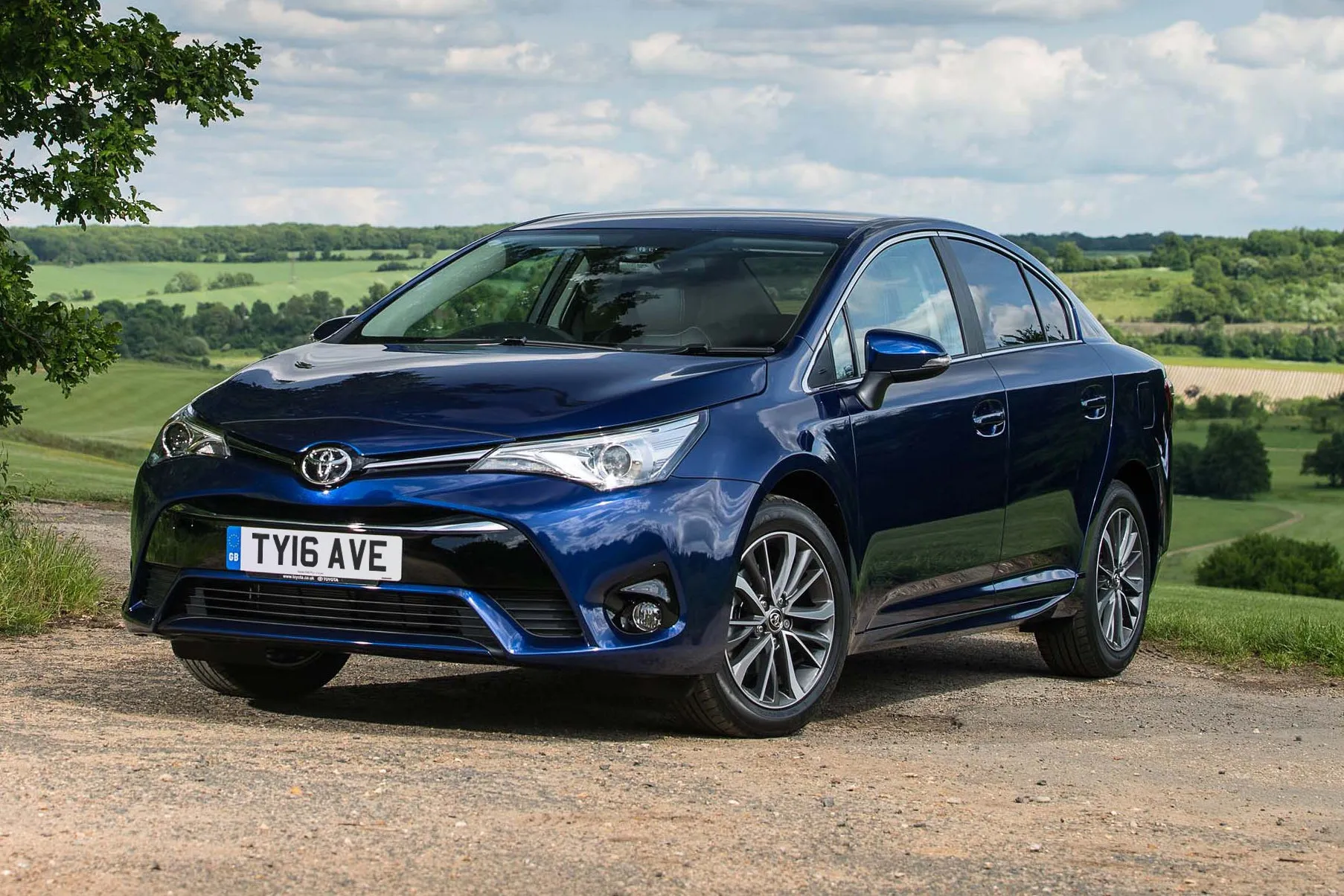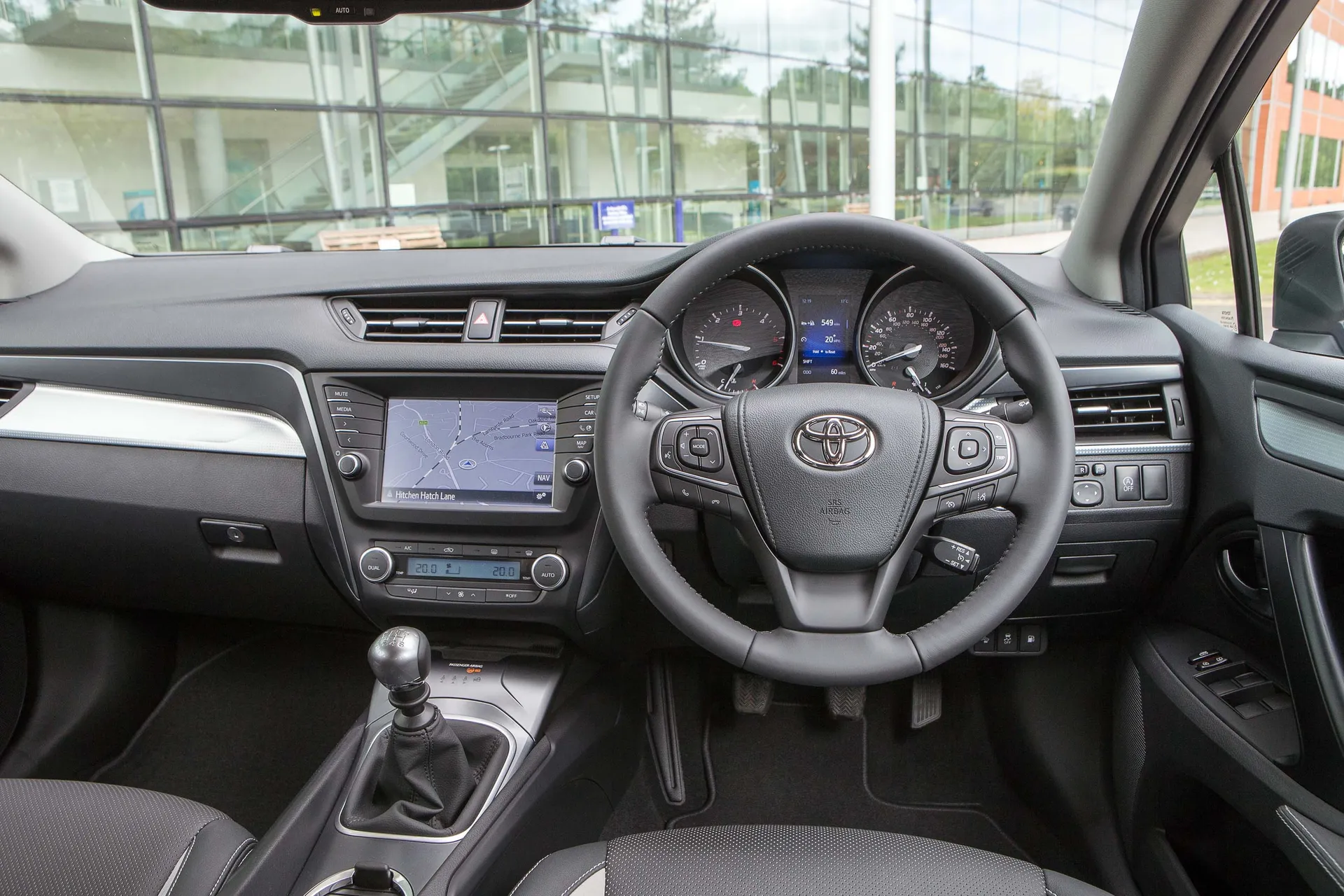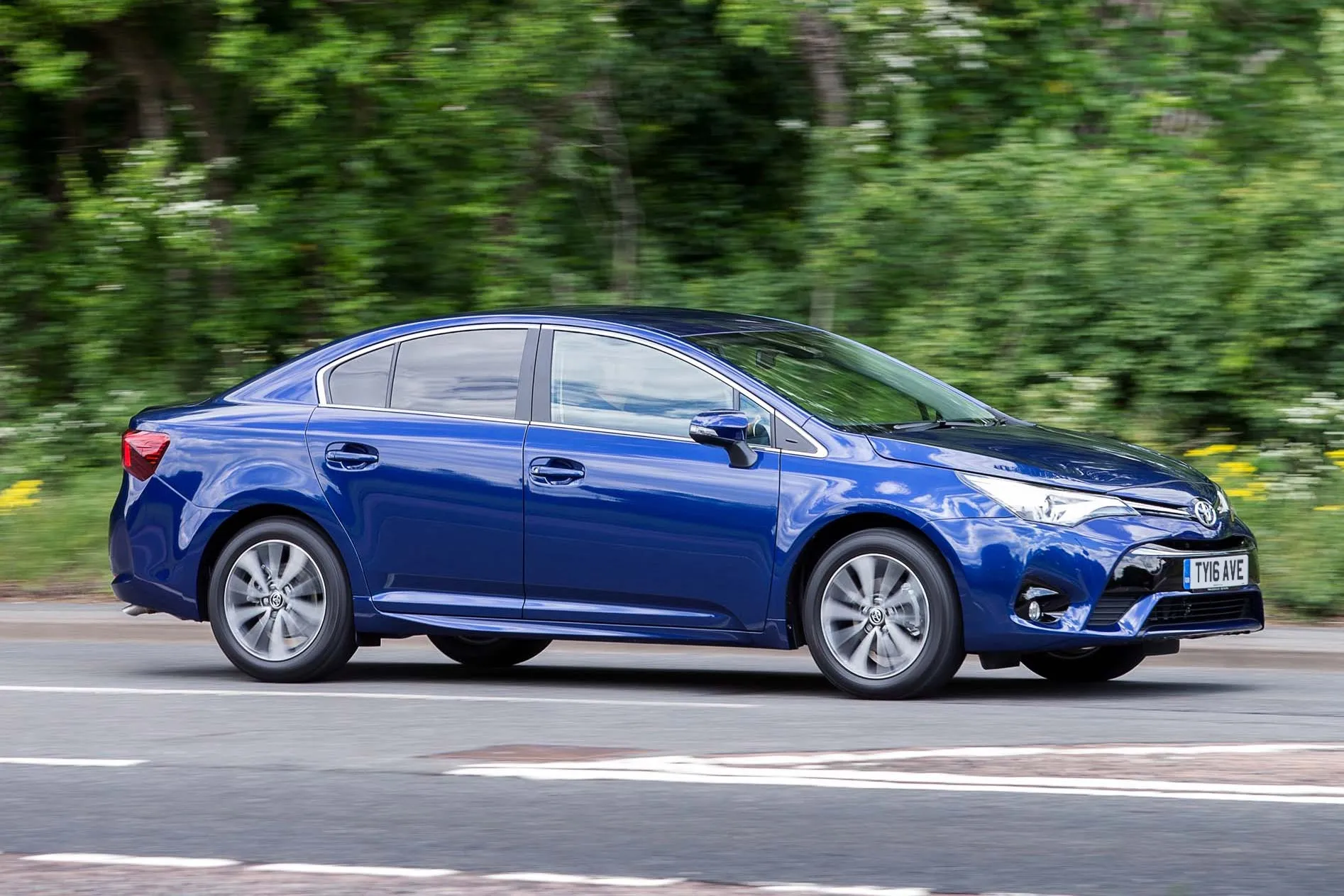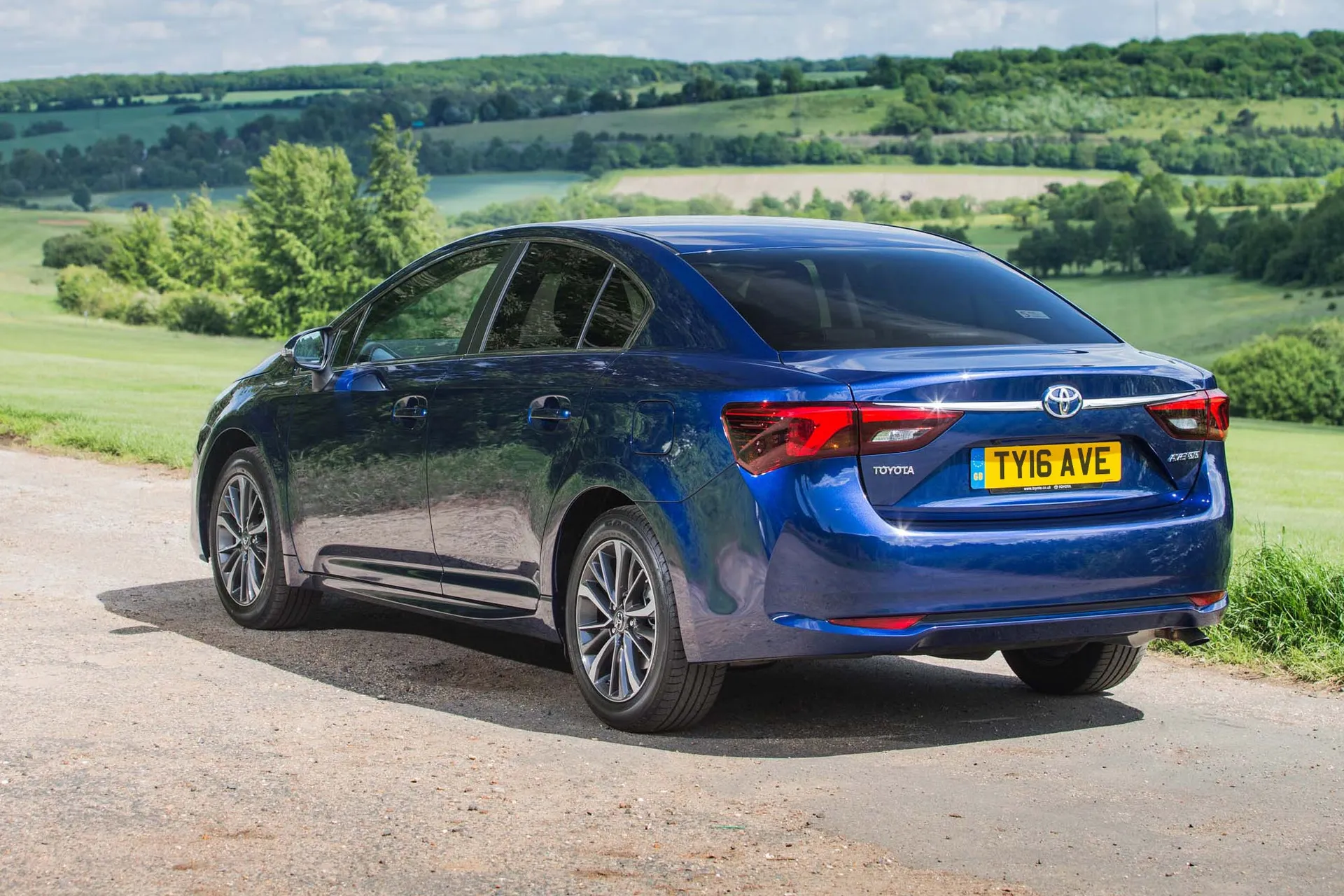Toyota Avensis (2015-2019) Review
Written by Andrew Brady
Quick overview
Pros
- Efficient BMW-sourced engines deliver excellent economy
- Superb long-legged ride comfort and refinement
- Long list of standard equipment
Cons
- Drab interior lacks flair and imagination
- Dull to drive
- 1.6 and 1.8 engines lack punch
Overall verdict on the Toyota Avensis
"Judged on what Toyota hoped to achieve with the Avensis, this was, and still is, a car that’s hard to fault. Not only did it offer exceptional value for money, but it was also one of the most comfortable cars in its class. Throw in cheap running costs and excellent reliability and you have the hallmarks of a great used car."

The Toyota Avensis was the car to buy when you had little imagination, right? Wrong. It might not have been the most dynamic, stylish or glamorous car out there, but as an efficient, reliable and comfortable family car, the Avensis was hard to beat.
Launched in 2015, the latest Avensis was a comprehensive reworking of the earlier car. Toyota gave it a subtle facelift, an improved cabin, more standard equipment, efficient engines, and an impressive suite of safety systems.
There were two versions available: a four-door saloon and a five-door Touring Sports (estate). Of the engines available, the BMW-sourced diesels are still the pick of the bunch.
The 1.6 D-4D diesel offered excellent economy and was designed for fleet users who spent most of their time in sixth gear. The 2.0 D-4D offered improved performance with only a small drop in fuel economy, which made it the best choice for family buyers or those who carried heavy loads.
Regardless of the engine, the Toyota Avensis was a car that prioritises comfort over handling. On motorways, the Avensis delivered the kind of long-legged feel and efficiency demanded by Europe’s company car drivers. The flip side was that the Avensis felt woefully out of its depth under cornering, with a fair amount of body roll and overly light steering.
You can make up your own mind on the styling, but there’s no doubt that the cabin was a drab affair. The dashboard was a sea of grey, lifted by some welcome silver accents in key places.
Quality was very good, with the switches, dials and buttons feeling reassuringly solid. Although standard equipment was generous for a car of this price, we’d still avoid the entry-level Avensis. The mid-range model offered the best blend of price and kit.
It also had a full suite of Toyota Safety Sense driver assistance systems, an eight-inch touchscreen, 17-inch alloy wheels, dual-zone climate control, a reversing camera, driver’s seat lumbar support and a DAB digital radio. It was the most popular model in the Avensis range, so you shouldn’t have any problems finding the right car.
Choosing the Toyota Avensis Tourer version delivered the best practicality. Although the boot wasn't the largest in its class, there was ample space for your luggage and for trips to the DIY store. The luggage capacity in the saloon was generous, but practicality was hampered by the narrow boot opening.
The cabin offered sufficient room for four adults – five at a push – along with a huge central storage bin and a large glovebox. We doubt you’d require more practicality and comfort from a family car.
We know many people are turning to crossovers and SUVs, but this means that cars like the Toyota Avensis are becoming used car bargains. You could run this car for many years without a problem, enjoying the comfort and efficiency as you go along. Try it. You might like it.
Looking for a used car for sale? We've got 100s of Toyota Approved Used Cars for Sale for you to choose from, including a wide range of Toyota Avensis models for sale. If you're looking for the older version, you need our Toyota Avensis (2009-2015) review.
Is the Toyota Avensis right for you?
Not everyone is after precision handling, exhilarating performance and head-turning looks from a saloon or estate car. Indeed, most people would be happy with a comfortable ride, zero problems between each scheduled service and running costs that won’t break the bank.
That’s where the Toyota Avensis comes in. It might lack glamour and kerb appeal, but it was one of the most sensible cars you can buy. Europe’s company car drivers can’t be wrong, can they?
The final iteration of the Avensis was the best of the breed; it had sharper styling, improved quality and a greater feeling of refinement. Of the two, the Touring Sports was the most practical and arguably the better-looking car.
If your idea of driving pleasure is measured in 0-62mph times and the way a car tackles a corner, the Avensis isn’t for you. On the other hand, if you’re after comfort and dependability, the Avensis is still a hugely satisfying car.
What's the best Toyota Avensis model/engine to choose?
For every day use, the base 1.6D with 112ps should be enough as it balances economy and performance. There's was a more powerful diesel engine available and it would be worth searching for the 143ps.
The Business trim offered good upgrades while the Excel was as far as you could go when speccing an Avensis from the factory.
What other cars are similar to the Toyota Avensis?
Its largest rivals were the Ford Mondeo and Mazda 6. Both were available as a saloon or estate, although the Ford and Mazda were much nicer to drive than the Toyota Avensis. These have since been canned, meaning a direct rival is oddly difficult to place. The new Ford Focus Estate has a larger boot, it's comfortable and comes with a mild hybrid engine, but there's no saloon. If the badge is important, it's worth looking at the newer Toyota Corolla.
Alternatively, you could look at the newest Volkswagen Passat or Skoda Superb, the latter is very impressive, indeed. Again, there are saloon and estate versions available for both, with the wagons offering greater practicality than the Avensis. There's also the latest Skoda Octavia if the Superb offers too much real estate for your lifestyle.
If you’re buying used, take a look at the Hyundai i40 for its long warranty and the Vauxhall Insignia Grand Sport for its motorway comfort and low prices.
Comfort and design: Toyota Avensis interior
"Although this final iteration of the Avensis is essentially a comprehensive facelift of the old version, Toyota made some significant changes in some key areas. As a result, this is the most comfortable Avensis you can buy."

Take the seats, which featured a larger upper backrest, redesigned backrest bolsters, reshaped cushion side bolsters and tweaked seat suspension to provide greater long-distance comfort. It worked. You could spend hours in an Avensis without feeling fatigued.
This is especially true of versions with lumbar support on the driver’s seat, which was a good reason to upgrade from the entry-level trim. Air conditioning was standard on the base model, but other versions got dual-zone climate control for added comfort.
The dashboard was utterly conventional and free of distractions. There were two clear dials ahead of the driver, which flanked a 4.2-inch TFT information display. This was monochrome on the base model and colour on the others.
Everything was arranged clearly and logically, right down to the controls for the air conditioning, which weren't relegated to the touchscreen. Speaking of which, the screen was also flanked by a set of large buttons, which made it easy to operate on the move.
Flair was in short supply, but the satin chrome accents on the dashboard, steering wheel, centre console, air vents and gear level delivered a small touch of class. Look, you'd never be uploading photos of the cabin to Instagram, but we liked the refreshing simplicity on show.
Quality and finish
All versions got a leather-trimmed steering wheel, which was a clever move by Toyota. It was the one thing you were guaranteed to come into contact with on every journey - a lovely touch.
Elsewhere, the Avensis might've lacked the soft-touch materials you'd find in some of its premium rivals, but you were not paying a premium price. Crucially, the switchgear felt tough and solid. We thought quality had gone up a notch or two over its predecessor.
The base model felt a little low-rent, partly because of the fabric seats and basic air conditioning. Upgrading to the next level added Alcantara inserts to the cloth seats, which was just enough to raise the level of quality. It helped that you also gained dual-zone climate control and lumbar support for the driver’s seat. Still, it’s a shame you had to select the flagship model to benefit from heated seats with electric adjustment.
It’s important to remember that although the Toyota Avensis scored low for perceived quality, the actual quality was surprisingly good. Take a look at an example with interstellar mileage on the clock and you’ll see that it looks as good as new.
Infotainment: Touchscreen, USB, sat-nav and stereo in the Toyota Avensis
The audio system in the entry-level Avensis was a bit basic, comprising a CD player, radio, Bluetooth and six speakers. Frankly, that’s not enough in this day and age.
Other versions boasted an eight-inch touchscreen infotainment system with Toyota Touch 2 and Go. This meant you got DAB digital radio and satellite navigation. The flagship model had advanced connectivity functions, 3D mapping, voice recognition and 10 speakers.
Thanks to a logical layout, the touchscreen was always easy to use on the move, while the display was crisp and clear. It was just a shame that the graphics looked so dated. Modern Toyotas are much improved in this regard, but the Avensis was discontinued before the changes came into effect. It also lacked Apple CarPlay and Android Auto connectivity, which will deter some buyers.
On the plus side, all versions came with audio controls on the steering wheel, while the 4.2-inch TFT display showed information relating to the audio, telephone, navigation and safety functions.
Space and practicality: Toyota Avensis boot space
Predictably, the Touring Sports was the hero when it came to space. It offered a cavernous 543 litres of luggage capacity with the rear seats in place which was more than you’d find in the Ford Mondeo estate (525 litres) and Mazda 6 Tourer (506 litres). That said the Volkswagen Passat offered a generous 650 litres of boot space.
Fold the seats down and you were greeted with 1,609 litres of luggage space. There was a useful storage area below the boot floor, a ski hatch for long loads, plus rear seats that folded 60/40.
On paper, the 590-litre boot in the Avensis saloon sounded quite large, but the practicality was hampered by a narrow opening, a poorly shaped boot and a high boot lip. The seats folded 60/40 which was handy if you needed to carry anything longer. One-touch flat-folding rear seats were also fitted as standard.
The positive vibes continued in the front where there was adequate space for four adults, or five at a push. That’s because space in the middle rear seat wasn't hampered by a transmission tunnel, which meant legroom was fine for occasional use.
Headroom was decent across the back row while the outer seats benefited from excellent legroom, even if the front seats were occupied by tall people. Up front, the driver and passenger would've had few complaints, as plenty of headroom and shoulder room were offered. The driver also benefited from excellent all-round visibility. The long car's length meant the reversing camera fitted to the mid-range Avensis was a must-have.
A word about children in the Avensis. While the car came with Isofix points on the outer rear seats, the narrow door openings meant fitting child seats was a struggle, which could become a pain over time.
Speaking of children, the central storage bin was almost large enough to house one of your offspring – it was one of the biggest we'd seen back then. It opened to reveal a cupholder to go with the one positioned next to the shift lever. There was also a large glovebox, although the door pockets were a little on the small side.
Handling and ride quality: What is the Toyota Avensis like to drive?
"If you’ve been paying attention, you’ll know that the Toyota Avensis would never set your pulse racing. In fact, the reverse is true, with the car configured to lower your heart rate as you while away the hours on a long drive."

Toyota will argue that the improvements made to the 2015 Avensis gave it greater dynamic appeal, but we’re talking fine margins. The Ford Mondeo and Mazda 6 were the default choices if you were looking for a car with sharp steering and fine handling.
That’s fine because the Avensis smashed both in ride comfort. Short of buying something from the luxury class, you were unlikely to find a car that was as cosetting as the Avensis. The one exception was the Skoda Superb, especially if you opted for one of the higher trim levels.
Chuck the Avensis into a corner and it would respond with a fair amount of body-roll and a general sense of heft. It didn't help that the steering was too light, although this was useful when you were in the city or manoeuvring into a parking space.
It dealt with road imperfections with aplomb, ironing out all but the worst potholes. It did this without the floaty and wallowing characteristics you might have felt in a rented American car on a fly-drive holiday. That said, if you attempted to take too many corners in quick succession, you felt like you were on a boat.
It was best to sit back and revel in the comfort of the Avensis. Although the difference was negligible, the ride quality was slightly better on the 16-inch steel wheels and the 17-inch alloys, but wasn't enough for us to advise against opting for a model with 18-inch wheels at the time.
What engines and gearboxes are available in the Toyota Avensis?
Although a petrol engine was available, we’d still recommend one of the two BMW-sourced diesel units.
The entry-level 112PS 1.6 D-4D was perfectly adequate if you intended to spend most of your time cruising along motorways. A 0-62mph time of 11.4 seconds for the saloon and a top speed of 115mph highlights the lack of poke. However, the claimed 67.3mpg on a combined cycle was worth the sacrifice in performance.
For added punch, the 143PS 2.0 D-4D is worth a look, especially in the Touring Sports. The 0-62mph time was cut to 9.5 seconds in the saloon or 9.8 seconds in the estate, with the top speed increased to 124mph. Figures of 58.9mpg to 62.8mpg represented a small dent in fuel economy, but as the 2.0 required less work to get it going, the actual difference was negligible.
The 1.8-litre Valvematic petrol was only advised if you spent your entire time in the city or wanted an automatic transmission. It was the quickest of the bunch, sprinting to 62mph in 9.4 seconds if you opted for the saloon with a manual gearbox when buying new, but it lacked the economy of the diesel units.
A 1.6-litre Valvematic petrol was available in some markets, but it wasn't powerful or efficient enough to make it a realistic prospect.
The six-speed manual was a satisfying gearbox, but it’s worth noting that the automatic on the 1.8 petrol was a CVT unit. It’s fine if left to its own devices, but it's noisy and frustrating while making swift progress.
Refinement and noise levels
Toyota put a lot of work into improving the noise, vibration and harshness levels of the Avensis, so it felt more refined than its predecessor.
Thicker sound insulation helped, as did the increased thickness and width of the seals used throughout the vehicle. There was improved insulation below the bonnet, while diesel models also benefitted from an underbody damping sheet. Toyota even reduced the noise of the air conditioning unit.
As you’d expect, there was still a gap between the Avensis and entry-level Lexus models, but this offered premium levels of refinement. It wasn't perfect. The diesel engines could be quite noisy when pushed, which was especially evident in the 1.6-litre version.
The CVT was refined and relaxed when cruising or accelerating without urgency, but it tended to rev too high and could be quite noisy when pressed hard, like many modern Toyotas. Overall, the 2.0-litre D-4D was and still is the most refined option, so it’s the version we’d recommend when buying used.
Safety equipment: How safe is the Toyota Avensis
The Toyota Avensis was awarded a maximum five-star safety rating when it was crash-tested by Euro NCAP in 2015.
It achieved an impressive set of results, including 93 percent for adult occupant protection, 85% for child occupant protection, 78% for pedestrian safety, and 81% for safety assist technology.
Central to this good result was the Toyota Safety Sense suite of driver assistance systems, which included lane departure alert, pre-collision system, automatic high beam and road sign assist.
All models received driver and front passenger airbags, front side airbags, a driver’s knee airbag, full-length curtain shield airbags, Isofix points for mounting child car seats, steering assist vehicle stability control, hill-start assist and automatic door locking.
Cruise control was standard across the range, as was an electronic parking brake and tyre pressure monitoring system. Rain-sensing wipers and dusk-sensing headlights were standard on all except the entry-level Avensis. The top trim model received dusk-sensing LED headlights with adaptive headlights.
MPG and fuel costs: What does a Toyota Avensis cost to run?
"Although the figures were achieved using the less reliable NEDC testing formula, the diesel engines in the Avensis should still be very economical. For example, the 1.6 D-4D could achieve 67.3mpg on a combined cycle."

The figure for the 2.0 D-4D varies according to the size of the alloy wheels. An Avensis saloon riding on 17-inch rims could return 62.8mpg, but this will likely drop to 58.9mpg on 18-inch wheels. The 1.8 petrol offered 46.3mpg to 47.9mpg.
According to Honest John Real MPG figures, a saloon with the 2.0 D-4D engine is the most economical, with a real-world figure of 47.1mpg.
Toyota Avensis reliability and warranty
With them being discontinued in 2019, the Avensis' five-year manufacturer warranty will be no more, unless the warranty has been extended.
Toyota's sixth in the latest HonestJohn.co.uk satisfaction index, scoring a 90.35 percent satisfaction rating. If you've spotted an Avensis, most of its issues should already be resolved during previous ownership although it's worth checking before parting with any hard-earned cash.
Toyota Avensis insurance groups and costs
Buying an Avensis saloon with a 1.6 D-4D diesel engine is a sure way to spend the least amount on car insurance. It slots into insurance group eight (out of 50) in Active trim or group nine in Business Edition trim. The cost will be slightly higher if you opt for the Design model (group 11).
The cost of insurance for the Avensis Touring Sports is roughly the same as the saloon, with groups ranging from eight to 16. This makes it significantly lower than the BMW 3 Series Touring (group 20 to 40).
VED car tax: What is the annual road tax on a Toyota Avensis?
Buy a Toyota Avensis registered on or after 1 April 2017 and you’ll mostly pay a flat rate of £195 for the first year of Vehicle Excise Duty (VED, or road tax) and £190 thereafter. 'Mostly' is the big hint here. Some of the 1.8 and 1.8 V-matic autos sit in Band H and emit shy of 150g/km of C02. This means you could pay £270 for your first year, but this will still fall back to £190 consecutively.
Buying an Avensis registered on or before 31 March 2017 could make more financial sense. A 1.6D Active registered from 1 April 2015 should emit just 109g/km of C02, putting it in Band B. This means you'll barely even notice the £20 per year tax payment. What's even better is you'll save £10 per year thereafter.
Toyota Avensis price
"The Toyota still represents incredible value for money on the used car market, with 2015 saloons available for as little as £3,000. The majority of cars available are ex-fleet vehicles in Business Edition trim. Sadly, these are way out of Toyota’s five-year warranty."

We spotted an early 2015 car in Business spec with just 37,400 miles for £3,500. You can dip lower, but most of these will have galactic mileage given their motorway-muncher persona.
If you're really keen, you can opt for a 2016 2.0-litre diesel for £12,000 with just 29,000 miles.
Trim levels and standard equipment
The entry-level Active trim featured 16-inch steel wheels, autonomous emergency braking, air conditioning, cruise control, hill-start assist, LED daytime running lights, an auto-dimming rear-view mirror, a six-speaker CD/radio system, Bluetooth and electric front windows.
Business Edition added 17-inch alloy wheels, Toyota Safety Sense, automatic high beam, lane-departure warning, road sign assist, an eight-inch touchscreen with Toyota Touch 2 and Go, DAB digital radio, a reversing camera, a colour TFT display, climate control, rain-sensing wipers, automatic headlights, all-round electric windows, cloth/Alcantra seats, driver’s seat lumbar support, electric door mirrors and front fog lights.
The Design trim (introduced in 2016) featured 18-inch alloys, Alcantara/leather seats and rear privacy glass. Meanwhile, Business Edition Plus models received 17-inch alloys, keyless entry and go, LED auto-levelling headlights and front fog lights with a cornering function.
At the top of the range, Excel trim boasted advanced connectivity, voice control, 10 speakers, 18-inch alloy wheels, heated front seats with electric adjustment, adaptive front lights and a panoramic roof (on the Touring Sports estate).
Get our latest advice, news and offers
Keep me updated by email with the latest advice, news and offers from heycar.
By submitting you agree to our privacy policy



